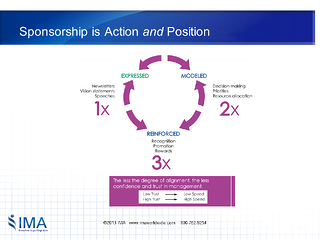Over the course of the past 25 years our change management consulting work has exposed us to a lot of misconceptions about what works and what doesn't work when it comes to implementing projects. We recently shared these 4 myths at the HIMSS (Health Information Management Systems Society) International Conference and found that the myths are alive and well in the world of Healthcare IT project implementations. 
How many of these myths are still commonly held in your own organization?
Myth #1: You can pick your own project Sponsor (or a Sponsor can volunteer for the assignment.)
Reality: Sponsorship is solely determined by organizational position and the action of the project Sponsors.
One thing we know from our change management consulting work is that no leader can raise his or her hand and say, "That's a great idea--I'll sponsor that" unless that leader has positional authority over the people who will be impacted by the change. It's not a voluntary position! Sponsors can either authorize the change (meaning that they approve and authorize the requisite resources-- time, people, materials, etc.) or they are Reinforcing Sponsors who must provide the positive rewards and negative consequences for those individuals who report to them and are impacted by the change.
Reinforcing Sponsors can also encourage the new behaviors the change is designed to elicit by making the new ways easier to adopt than maintaining the old behaviors.
If a leader has no positional authority that means that the leader can't apply the rewards and consequences. And so they are not in a position to be a Sponsor.
By the way, this is why Steering Committees can't serve as Sponsors. They generally have no positional authority! When Steering Committees are established as a "substitute" for developing Sponsorship you have a huge governance problem! You can use Steering Committees as decision-making bodies but you will still need to have Sponsors at each level of the organization and in every area impacted by the change.
Myth #2: Sponsor written and verbal communication drives the change.
Reality: The change is driven by the "cascade" of Sponsors at each level that demonstrate commitment by what they say, what they do, and most importantly,
what they reinforce.
In our change management consulting work with leaders this may well be the biggest "aha." Clients have operated under the false assumption that if there is just better communication they would be able to execute changes more successfully.
So the "change management plan" is assumed to be a communication and training plan. Not so!
The pace of change is determined by the ability of those Reinforcing Sponsors at each level to demonstrate their active commitment to the change by what they express, model, and reinforce. It's not determined by the frenetic activity of project teams and Change Agents.
Going back to myth #1, this is the "action" we're referring to in the definition of Sponsorship as both "action and position."
Myth 3: Your Sponsors are only really needed at project launch.
Reality: You need your Sponsors to be active for the entire project Lifecyle.
This is the case of the missing Sponsor!
Once you re-define the role of Sponsor, it makes sense that Sponsors need to be very active at every stage of the project. You will need different actions depending on where you are in the lifecycle. In fact, one of the greatest challenges Change Agents face is getting sustained Sponsorship.
This is why when we work with Sponsors as change management consultants we ask for permission to "re-contract" later on in the project. We call this "contracting to re-contract."
Remember that there are 6 tasks that Sponsors can't delegate to Change Agents at any point in time.
1.Establish and communicate the Business Case for Action
2.Participate in goal setting
3.Allocate resources
4.Concentrate their energies on their direct reports by starting and/or continuing cascading Sponsorship
5.Align/apply reward systems for their direct reports
6.Monitor progress constantly!
Myth #4: The Executive Sponsor has more impact on reinforcing a change than anyone else.
Reality: The Executive Sponsor can really only reinforce new behaviors directly with his or her own direct reports. It is the cascade of Express, Model, and Reinforce behaviors that accelerates adoption of changes.
One of the most difficult truths for Sponsors to accept is that the reinforcement for changing behavior comes from a Target's own boss, not from the Executive. Many changes stall out because the Executive Sponsor fails to start the cascade of demonstrated commitment with his own direct reports, falsely assuming that these senior leaders will just do the right thing.
In so many cases we are called in to do remedial work as change management consultants because there is no alignment or Sponsorship at the VP/Director level. It's not unusual to find a hotbed of resistance right at the top!
If you are a Change Agent looking to break through the barriers to change on your business change projects, being aware of these myths will greatly enhance your likelihood of execution success.

